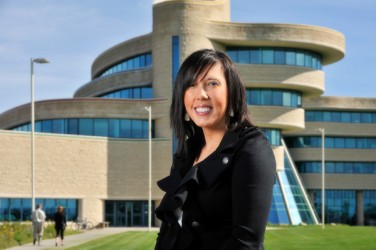Article Origin
Volume
Issue
Year
Dr. Carrie Bourassa, associate professor of Indigenous health studies at First Nations University of Canada (FNUniv), was one of 28 leaders invited to share their views on how to improve health at the Building on Strengths Roundtable Dialogue on Aboriginal health which took place at Rideau Hall on March 27.
One of the conclusions of the groups was that self-determination will play a huge role in improving health prospects for Canada’s Aboriginal communities.
The event was organized by the National Expert Commission and the Canadian Nurses Association, and was hosted by Sharon Johnston, wife of Governor General David Johnston.
“Their goal was to bring community members and leaders from both Aboriginal and non-Aboriginal com-munities, that were in various health fields, and they wanted to talk about the social and environmental determinants of health and how that impacted the health and well-being of Aboriginal Canadians. And also, to generate some solutions that would improve Aboriginal health,” Bourassa said.
Bourassa teaches Indigenous health studies at FNUniv, and serves as the nominated principal investigator for the Indigenous Peoples’ Health Research Centre. One message flowing from her work is that Canada’s Indigenous peoples face numerous systemic barriers within the health care system.
“Everybody around the table agreed that there is systemic racism [in the system] and that we will have to deal with it,” Bourassa said. “I work a lot around ‘culturally safe’ care and how to provide it. When you work in the communities, you hear the same thing over and over from First Nations and Metis peoples that they are not getting quality care, and a lot of that is around those systemic barriers.”
The cultural misunder-standings may be small, but cause considerable stress.
For example, when a critically ill First Nations person is in hospital, surrounded by family members, there is a tendency among non-Aboriginal hospital staff to see it as a space management problem, rather than as a sign of a caring community.
“You hear, ‘How come they always have so many people in the waiting room?’ They fail to understand how important it is for that family to be there,” Bourassa said.
Likewise, there was agreement on the need to address the proliferation of chronic diseases, such as diabetes among Canada’s Indigenous peoples. Bourassa said while the recent explosion in obesity and diabetes rates is North America-wide, the causes are compounded among First Nations, Métis and Inuit peoples.
“When you talk about chronic diseases, you have to talk about poverty,” Bourassa said. “If you have diabetes, you know you have to eat better, but it comes down to having access to healthy food.”
For people living in remote communities, fresh, healthy foods are often prohibitively expensive, if they are available at all. The problem isn’t in knowing what you should be eating. It’s being able to obtain it in the first place.
“People tell us, ‘We have a convenience store. There’s pop and chips and milk, and we’re lucky that they do have milk,’” Bourassa said. “You can’t label someone ‘non-compliant in their treatment program’ if they can’t afford to follow it.”
Bourassa said the result can be a sense of hopelessness that affects whole communities.
One of the solutions the roundtable agreed on was the need to recruit and train more Aboriginal health professionals, both physicians and nurses as well as academics to further the research necessary to implement changes in the system.
“There is a difficulty in attracting people to the health sciences and much more attention needs to be paid to it,” Bourassa said. “I have found some of the barriers are a feeling [among Aboriginal students] that they can’t do the math and sciences... even though they are perfectly capable of it.”
Roundtable participants agreed there is a need to break down existing bureaucratic barriers between policy, health care delivery and social services, and to create an integrated system that serves individuals, families and communities at the ground level.
Bourassa believes self-determination, at the national and community level, is the key to bringing about positive change for Canada’s First Nations, Metis and Inuit peoples.
“Where communities are engaged is where you see changes happen,” she said, citing one of her ongoing community health studies launched in 2003.
“We didn’t have any baseline health data for Metis in Saskatchewan. What we found right away was that there were high smoking rates and high rates of cardiovascular disease,” Bourassa said.
Rather than lecture smokers, Bourassa and her team launched the Green Light campaign.
“We gave a green light to each smoke-free home. They loved it. That was followed up with a second phase involving peer training on smoking cessation. This is a bit of self-determination for them, and the community is fully engaged,” she said. “We haven’t compiled the data to see how successful the program has been, but we ran out of green light bulbs.”
The National Expert Commission will now analyze the results of the roundtable to provide a report to the Canadian Nurses Association in June.
- 3721 views

